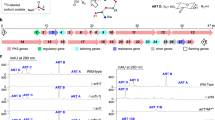Abstract
Clorobiocin is an aminocoumarin antibiotic containing a 5-methylpyrrolyl-2-carboxyl moiety, attached by an ester bond to a deoxysugar. This pyrrolyl moiety is important for the binding of the antibiotic to its biological target, the B subunit of gyrase. Inactivation experiments had shown that two putative acyl carrier proteins, CloN5 and CloN1, and two putative acyl transferases, CloN2 and CloN7, are involved in the transfer of the pyrrolyl-2-carboxyl moiety to the deoxysugar. In this study, pyrrolyl-2-carboxyl-N-acetylcysteamine thioester was synthesized and fed to cloN1 −, cloN2 − and cloN7 − mutants, and secondary metabolite formation was analyzed by HPLC and HPLC-MS. Transfer of the pyrrolyl-2-carboxyl moiety was observed in the cloN1 − and cloN2 − mutants, but not in the cloN7 − mutant, suggesting that CloN7 is responsible for this reaction. The product of this transfer, novclobiocin 109, was not further methylated to the 5-methylpyrrolyl-2-carboxyl compound, i.e. clorobiocin, suggesting that methylation does not take place after the acyl transfer. Additional investigations for the presence of 5-methylpyrrolyl-2-carboxylic acid in the mutants, and inactivation experiments with the methyltransferase gene cloN6, suggested that methylation by CloN6 and acyl transfer by CloN7 take place in a concerted fashion, requiring the presence of both proteins for efficient product formation. A mechanism for the methylation/acyl transfer process in the late steps of clorobiocin biosynthesis, involving CloN1, CloN2, CloN5, CloN6 and CloN7 is suggested.







Similar content being viewed by others
References
Datsenko KA, Wanner BL (2000) One-step inactivation of chromosomal genes in Escherichia coli K-12 using PCR products. Proc Natl Acad Sci USA 97:6640–6645
Dürr C, Schnell HJ, Luzhetskyy A, Murillo R, Weber M, Welzel K, Vente A, Bechthold A (2006) Biosynthesis of the terpene phenalinolactone in Streptomyces sp. Tu6071: analysis of the gene cluster and generation of derivatives. Chem Biol 13:365–377
Eustáquio AS, Gust B, Galm U, Li S-M, Chater KF, Heide L (2005) Heterologous expression of novobiocin and clorobiocin biosynthetic gene clusters. Appl Environ Microbiol 71:2452–2459
Freitag A, Wemakor E, Li SM, Heide L (2005) Acyl transfer in clorobiocin biosynthesis: involvement of several proteins in the transfer of the pyrrole-2-carboxyl moiety to the deoxysugar. Chembiochem 6:2316–2325
Garneau S, Dorrestein PC, Kelleher NL, Walsh CT (2005) Characterization of the formation of the pyrrole moiety during clorobiocin and coumermycin A1 biosynthesis. Biochemistry 44:2770–2780
Garneau-Tsodikova S, Stapon A, Kahne D, Walsh CT (2006) Installation of the Pyrrolyl-2-carboxyl Pharmacophore by CouN1 and CouN7 in the Late Biosynthetic Steps of the Aminocoumarin Antibiotics Clorobiocin and Coumermycin A(1). Biochemistry 45:8568–8578
Kieser T, Bibb MJ, Buttner MJ, Chater KF, Hopwood DA (2000) Practical Streptomyces Genetics, 2nd edn. John Innes Foundation, Norwich
Lewis RJ, Singh OMP, Smith CV, Skarzynski T, Maxwell A, Wonacott AJ, Wigley DB (1996) The nature of inhibition of DNA gyrase by the coumarins and the cyclothialidines revealed by X-ray crystallography. EMBO J 15:1412–1420
Li S-M, Heide L (2005) New aminocoumarin antibiotics from genetically engineered Streptomyces strains. Curr Med Chem 12:419–427
MacNeil DJ, Gewain KM, Ruby CL, Dezeny G, Gibbons PH, MacNeil T (1992) Analysis of Streptomyces avermitilis genes required for avermectin biosynthesis utilizing a novel integration vector. Gene 111:61–68
Maxwell A, Lawson DM (2003) The ATP-binding site of type II topoisomerases as a target for antibacterial drugs. Curr Top Med Chem 3:283–303
Pojer F, Li S-M, Heide L (2002) Molecular cloning and sequence analysis of the clorobiocin biosynthetic gene cluster: new insights into the biosynthesis of aminocoumarin antibiotics. Microbiology 148:3901–3911
Sambrook J, Russell DW (2001) Molecular cloning. A laboratory manual, 3rd edn. Cold Spring Harbor Laboratory Press, New York
Stachelhaus T, Huser A, Marahiel MA (1996) Biochemical characterization of peptidyl carrier protein (PCP), the thiolation domain of multifunctional peptide synthetases. Chem Biol 3:913–921
Wang Z-X, Li S-M, Heide L (2000) Identification of the coumermycin A1 biosynthetic gene cluster of Streptomyces rishiriensis DSM 40489. Antimicrob Agents Chemother 44:3040–3048
Westrich L, Heide L, Li S-M (2003) CloN6, a novel methyltransferase catalysing the methylation of the pyrrole-2-carboxyl moiety of clorobiocin. Chembiochem 4:768–773
Xu H, Kahlich R, Kammerer B, Heide L, Li S-M (2003) CloN2, a novel acyltransferase involved in the attachment of the pyrrole-2-carboxyl moiety to the deoxysugar of clorobiocin. Microbiology 149:2183–2191
Acknowledgment
This work was supported by the Deutsche Forschungsgemeinschaft (SPP 1152) and by the Fonds der Chemischen Industrie (fellowship T. Gulder and research funds).
Author information
Authors and Affiliations
Corresponding author
Rights and permissions
About this article
Cite this article
Anderle, C., Alt, S., Gulder, T. et al. Biosynthesis of clorobiocin: investigation of the transfer and methylation of the pyrrolyl-2-carboxyl moiety. Arch Microbiol 187, 227–237 (2007). https://doi.org/10.1007/s00203-006-0190-9
Received:
Revised:
Accepted:
Published:
Issue Date:
DOI: https://doi.org/10.1007/s00203-006-0190-9




